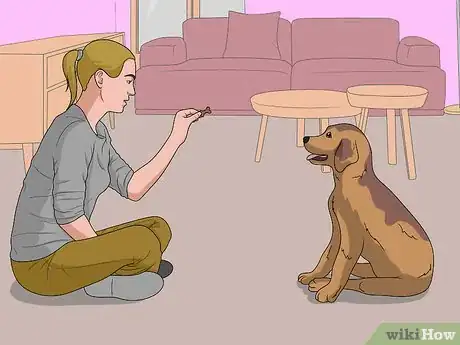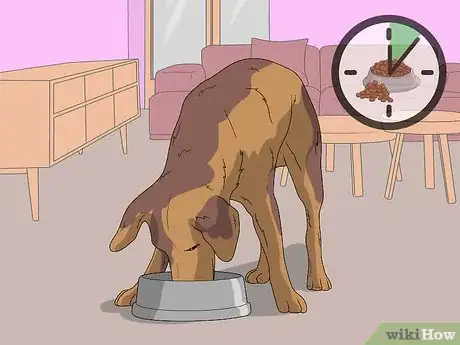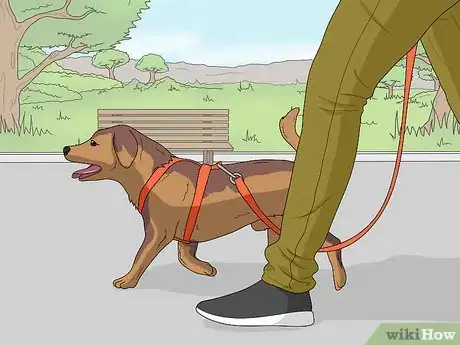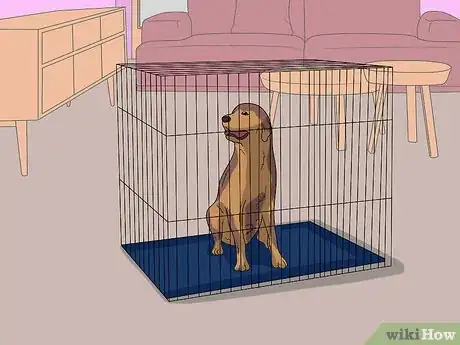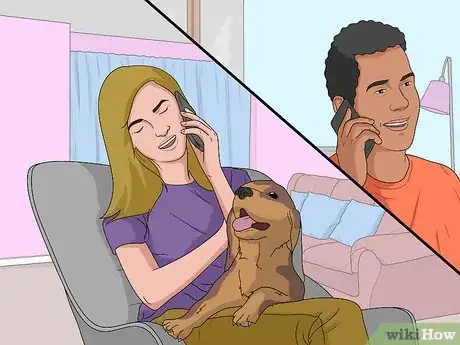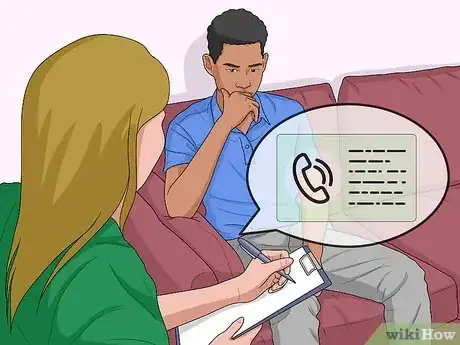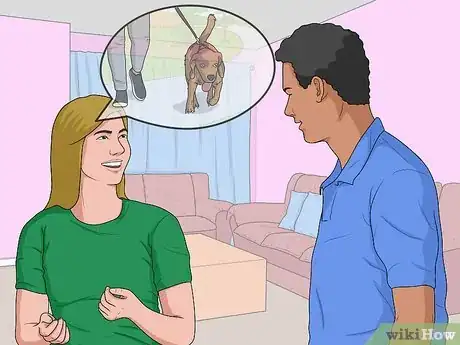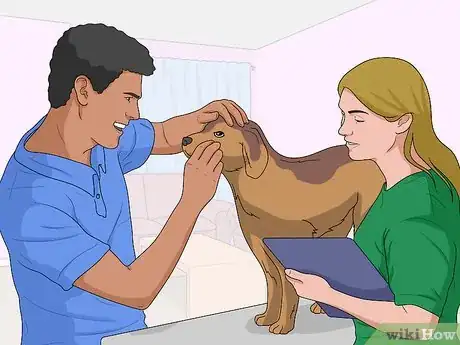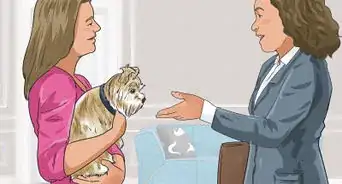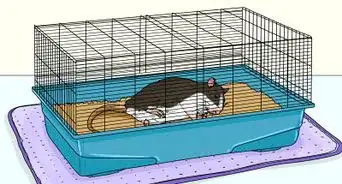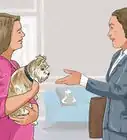This article was co-authored by Elisabeth Weiss and by wikiHow staff writer, Hannah Madden. Elisabeth Weiss is a Professional Dog Trainer and owner of Dog Relations NYC, a dog training service in New York, New York. Elisabeth relies on science-based, force-free, and reward-based techniques. Elisabeth offers behavior training, puppy manners, body awareness and injury prevention, diet, exercise and dog nutrition services. Her work has been featured in New York Magazine and on the Dog Save the People podcast. She also trained all the dogs in the movie "Heart of a Dog" by Laurie Anderson that features Elisabeth's journey with Laurie Anderson's and Lou Reed's dog Lolabelle and how her passion for playing the keyboards played a significant role in improving her quality of life after being diagnosed with pancreatic cancer.
There are 9 references cited in this article, which can be found at the bottom of the page.
wikiHow marks an article as reader-approved once it receives enough positive feedback. In this case, 93% of readers who voted found the article helpful, earning it our reader-approved status.
This article has been viewed 77,594 times.
If you have a friend or a family member with a dog, you may have been asked to pet sit for them. While it can sound a little intimidating, watching someone’s dog while they’re away can be fun for both you and the animal! Make sure you get all the information you need before their owner leaves to make dog sitting a positive experience for you and the pup.
Steps
Supplies You'll Need
-
1Feed the dog using their own food and dish. Make sure you know where their food is and how much to give them. Try not to feed the dog using anything other than their own dog food, or it could upset their stomach.[1]
- The dog might eat dry food, wet food, or a mixture of both.
-
2Bring along toys and treats to play with the dog. If the dog is allowed to have treats, you can pick some up at your local pet store along with a few toys. If you show up with fun things, there’s a higher chance the dog will like you![2]
- Tennis balls, frisbees, and tug-o-war toys are all great ones for dogs of any size.
- Check in with the owner before giving the dog any treats. Some dogs have allergies or sensitive stomachs, which won’t be any fun to deal with while you’re pet sitting.
Advertisement -
3Use a leash and harness for walks. If you plan on taking the dog out for a walk, make sure you know where their leash and harness are. Always use their own harness in the dog’s size so they can’t slip out and escape while you’re out with them.[3]
- Some dogs may go on walks using a leash and a collar, which is fine too.
- Don’t forget to bring poop bags!
Care Tips
-
1Let the dog get comfortable with you on their own terms. When you first meet the dog, just act natural and let them come to you. Don't try to immediately handle the dog, and don't stare at them. If you're relaxed, the dog will be more likely to relax around you.[4]
- Try tossing treats onto the ground. That will make the dog more comfortable than if you try to feed them by hand.[5]
-
2Stick to the dog’s normal feeding schedule. Dogs are very routine-based, and they’ll be confused if they get fed early or late. Try to feed them based on the schedule they’re used to so they don’t get too hungry.[6]
- Most dogs get fed a morning meal and an evening meal, but this can change based on the dog and the owner.
-
3Walk the dog and play with them to get their energy out. Dogs get bored if they’re sitting at home for too long. Make sure you walk them, play with them, and give them lots of treats (if they can have any).[7]
- Younger dogs and puppies need a lot of attention throughout the day. Older dogs may be content with sleeping or resting on their own for a while.
-
4Secure the dog when you leave the house. If the dog owner has left you instructions on where to put the dog when you leave, make sure you do it! Dogs have a tendency to get anxious when they’re alone, so they may need to be put in a crate or a separate area of the house when you’re gone.[8]
- This could be a crate, an exercise pen, a separate room, or behind a baby gate.
- Not every dog needs to be secured, especially older dogs. If the owner didn’t mention anything about putting them away, don’t worry about it.
-
5Call the owner if anything goes wrong. If you have questions about the dog, if they get lost, or if they run away, call their owner right away. They may be able to help you find a solution to your problem.[9]
- It’s not likely that a problem will happen when you’re dog sitting, so you don’t have to worry about it the whole time! It’s important to be prepared just in case, though.
-
6Take the dog to an emergency vet if they get sick or in an accident. It’s always good to be prepared for the worst. If the dog you’re watching loses consciousness, has a seizure, or gets into an accident, take them to a 24-hour emergency vet right away.[10]
- If you end up taking the dog to a vet, contact the owners, too. They’ll probably want to know that something is wrong.
The Logistics
-
1Decide whether to dog sit at your house or the owner’s. If you’re going to bring the dog to your house, make sure you have a pet-friendly home where the dog can run around and play. If you have any pets of your own, consider whether or not they’ll be okay with a new dog in their environment.[11]
- If you’re going to dog sit at the owner’s house, talk to them about whether you’ll be spending the night or just stopping by once or twice throughout the day.
- Make sure you get a key to the owner’s home if you plan on going over there.
- Dog sitting is usually easiest if you keep the dog in their own home. They’ll be more comfortable in their own environment and you won’t have to worry about transporting them anywhere.
- You can also talk about how much you’d like to be paid. Most dog sitters make around $35 per night, but that can change based on how often you’re going over and how many pets are in the home.[12]
-
2Write down the owner’s contact info and emergency information. Get the name and number of the dog’s vet and any emergency vet services in the area. Make sure the owner has your contact info, too, just in case they need to get ahold of you.[13]
- In the US, the number for animal poison control is (888) 426-4435. You can call this number if the dog eats something that they shouldn’t have.
-
3Ask about the dog’s dietary needs. Talk about portions, where the food is kept, and how much the dog can eat every day. You can also ask about their treats and any allergies the dog has.[14]
- Never feed a dog chocolate, grapes, milk, cheese, onions, nuts, garlic, yeasted bread, avocados, or anything with caffeine. If the owners haven’t given their okay, don’t feed the dog anything other than their own food.[15]
-
4Talk about the dog’s exercise routine. Younger dogs and puppies might need multiple walks and playtime every day, while older dogs may need a little less attention. Talk to the owner about their dog’s schedule to see what you need to do for them every day.[16]
- The dog might have toys and games that they like to play, too.
- If you’re going to walk the dog, make sure you know where their leash and harness are. That way, you can walk them safely without a chance of them getting loose.
- If you plan on taking the dog out in public, ask the owner about how they are around other animals and kids. If the dog is aggressive or nervous around other people, you may want to stick to less populated areas.
-
5Meet the dog before you start dog sitting. Some dogs are aggressive, don’t like strangers, or have a lot of medical needs. If you can, try to go over to the house at least once to meet the dog and learn more about them. If you don’t think you can handle the dog, it’s okay to say no.[17]
- Most dogs will be shy or nervous when meeting a new person, so don’t take it personally!
- Start out slow when you first meet the dog by offering them your hand to sniff. After they’ve checked you out a little bit, go in for a pat on the head.
Expert Q&A
Did you know you can get expert answers for this article?
Unlock expert answers by supporting wikiHow
-
QuestionHow do I make a dog comfortable when I'm dog sitting?
 Elisabeth WeissElisabeth Weiss is a Professional Dog Trainer and owner of Dog Relations NYC, a dog training service in New York, New York. Elisabeth relies on science-based, force-free, and reward-based techniques. Elisabeth offers behavior training, puppy manners, body awareness and injury prevention, diet, exercise and dog nutrition services. Her work has been featured in New York Magazine and on the Dog Save the People podcast. She also trained all the dogs in the movie "Heart of a Dog" by Laurie Anderson that features Elisabeth's journey with Laurie Anderson's and Lou Reed's dog Lolabelle and how her passion for playing the keyboards played a significant role in improving her quality of life after being diagnosed with pancreatic cancer.
Elisabeth WeissElisabeth Weiss is a Professional Dog Trainer and owner of Dog Relations NYC, a dog training service in New York, New York. Elisabeth relies on science-based, force-free, and reward-based techniques. Elisabeth offers behavior training, puppy manners, body awareness and injury prevention, diet, exercise and dog nutrition services. Her work has been featured in New York Magazine and on the Dog Save the People podcast. She also trained all the dogs in the movie "Heart of a Dog" by Laurie Anderson that features Elisabeth's journey with Laurie Anderson's and Lou Reed's dog Lolabelle and how her passion for playing the keyboards played a significant role in improving her quality of life after being diagnosed with pancreatic cancer.
Professional Dog Trainer
-
QuestionHow do I babysit a dog in a location they are not familiar with?
 Community AnswerThey are more likely to be anxious in an unfamiliar location. Try to get them used to your presence by letting them sniff your hand and playing with them or taking them for a walk. Make sure you pay close attention to them around the house because they may destroy things due to the anxiety.
Community AnswerThey are more likely to be anxious in an unfamiliar location. Try to get them used to your presence by letting them sniff your hand and playing with them or taking them for a walk. Make sure you pay close attention to them around the house because they may destroy things due to the anxiety. -
QuestionWhat happens if the dog has never met a cat before, and the person who's taking care of the dog has one?
 Community AnswerUsually dogsitting is done at the home of the owner, not your own home, so there would be no reason for the dog to meet the cat. If you were to bring the dog to your own house, you would have to either keep the animals separate or introduce them very carefully. See How to Introduce Dogs to Cats.
Community AnswerUsually dogsitting is done at the home of the owner, not your own home, so there would be no reason for the dog to meet the cat. If you were to bring the dog to your own house, you would have to either keep the animals separate or introduce them very carefully. See How to Introduce Dogs to Cats.
Warnings
- Take the dog to a vet if you notice anything wrong with them.⧼thumbs_response⧽
- Call animal poison control at (888) 426-4435 if the dog eats anything they aren’t supposed to.⧼thumbs_response⧽
References
- ↑ https://www.aspca.org/pet-care/dog-care/general-dog-care
- ↑ https://www.aspca.org/pet-care/dog-care/canine-diy-enrichment
- ↑ https://www.nextavenue.org/perks-pet-sitter/
- ↑ Elisabeth Weiss. Professional Dog Trainer. Expert Interview. 3 September 2020.
- ↑ Elisabeth Weiss. Professional Dog Trainer. Expert Interview. 3 September 2020.
- ↑ https://other-peoples-pets.com/how-to-dog-sit-for-a-friend/
- ↑ https://other-peoples-pets.com/how-to-dog-sit-for-a-friend/
- ↑ https://www.bluecross.org.uk/pet-advice/home-alone-separation-anxiety-dogs
- ↑ https://other-peoples-pets.com/how-to-dog-sit-for-a-friend/
- ↑ https://www.aspca.org/pet-care/general-pet-care/emergency-care-your-pet
- ↑ https://www.nextavenue.org/perks-pet-sitter/
- ↑ https://www.angieslist.com/research/pet-house-sitting/
- ↑ https://other-peoples-pets.com/how-to-dog-sit-for-a-friend/
- ↑ https://other-peoples-pets.com/how-to-dog-sit-for-a-friend/
- ↑ https://www.aspca.org/pet-care/animal-poison-control/people-foods-avoid-feeding-your-pets
- ↑ https://www.aspca.org/pet-care/dog-care/general-dog-care
- ↑ https://other-peoples-pets.com/how-to-dog-sit-for-a-friend/
About This Article
To make dog sitting a positive experience for you and the dog, make sure to meet the dog before the owner goes away to get it used to your presence. Then, talk to the owner about the dog’s daily routine, since dogs often experience anxiety if their schedules change. For example, ask about feeding times, and when and how often the dog should be walked each day. Once it's in your care, be patient if the dog starts acting badly, since it's probably anxious from missing its owner. Instead of scolding the dog, try calming it down by taking it for a walk. For more advice from out Veterinary reviewer, including how to keep the dog safe and secure when you leave the house, keep reading.



